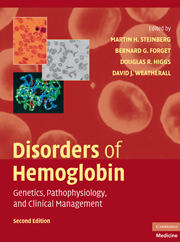Book contents
- Frontmatter
- Contents
- List of Contributors
- Foreword, by H. Franklin Bunn
- Preface
- Introduction, by David J. Weatherall
- SECTION ONE THE MOLECULAR, CELLULAR, AND GENETIC BASIS OF HEMOGLOBIN DISORDERS
- 1 A Developmental Approach to Hematopoiesis
- 2 Erythropoiesis
- 3 The Normal Structure and Regulation of Human Globin Gene Clusters
- 4 Nuclear Factors That Regulate Erythropoiesis
- 5 Molecular and Cellular Basis of Hemoglobin Switching
- 6 Structure and Function of Hemoglobin and Its Dysfunction in Sickle Cell Disease
- 7 Hemoglobins of the Embryo, Fetus, and Adult
- SECTION TWO PATHOPHYSIOLOGY OF HEMOGLOBIN AND ITS DISORDERS
- SECTION THREE α THALASSEMIA
- SECTION FOUR THE β THALASSEMIAS
- SECTION FIVE SICKLE CELL DISEASE
- SECTION SIX OTHER CLINICALLY IMPORTANT DISORDERS OF HEMOGLOBIN
- SECTION SEVEN SPECIAL TOPICS IN HEMOGLOBINOPATHIES
- SECTION EIGHT NEW APPROACHES TO THE TREATMENT OF HEMOGLOBINOPATHIES AND THALASSEMIA
- Index
- Plate section
- References
5 - Molecular and Cellular Basis of Hemoglobin Switching
from SECTION ONE - THE MOLECULAR, CELLULAR, AND GENETIC BASIS OF HEMOGLOBIN DISORDERS
Published online by Cambridge University Press: 03 May 2010
- Frontmatter
- Contents
- List of Contributors
- Foreword, by H. Franklin Bunn
- Preface
- Introduction, by David J. Weatherall
- SECTION ONE THE MOLECULAR, CELLULAR, AND GENETIC BASIS OF HEMOGLOBIN DISORDERS
- 1 A Developmental Approach to Hematopoiesis
- 2 Erythropoiesis
- 3 The Normal Structure and Regulation of Human Globin Gene Clusters
- 4 Nuclear Factors That Regulate Erythropoiesis
- 5 Molecular and Cellular Basis of Hemoglobin Switching
- 6 Structure and Function of Hemoglobin and Its Dysfunction in Sickle Cell Disease
- 7 Hemoglobins of the Embryo, Fetus, and Adult
- SECTION TWO PATHOPHYSIOLOGY OF HEMOGLOBIN AND ITS DISORDERS
- SECTION THREE α THALASSEMIA
- SECTION FOUR THE β THALASSEMIAS
- SECTION FIVE SICKLE CELL DISEASE
- SECTION SIX OTHER CLINICALLY IMPORTANT DISORDERS OF HEMOGLOBIN
- SECTION SEVEN SPECIAL TOPICS IN HEMOGLOBINOPATHIES
- SECTION EIGHT NEW APPROACHES TO THE TREATMENT OF HEMOGLOBINOPATHIES AND THALASSEMIA
- Index
- Plate section
- References
Summary
INTRODUCTION
Hemoglobin switching is characteristic of all animal species that use hemoglobin for oxygen transport. Most species have only one switch, from embryonic to adult globin formation. Humans and a few other mammals have two globin gene switches, from embryonic to fetal globin coinciding with the transition from embryonic (yolk sac) to definitive (fetal liver) hematopoiesis and from fetal to adult globin formation, occurring around the perinatal period (Fig. 5.1; see Chapters 1 and 2). The switch from ε- to γ-globin production begins very early in gestation, as fetal hemoglobin (HbF) is readily detected in 5-week-old human embryos, and it is completed well before the 10th week of gestation. β-globin expression starts early in human development, and small amounts of adult hemoglobin (HbA) have been detected by biosynthetic or immunochemical methods even in the smallest human fetuses studied. In these fetuses γ- and β-globins are present in the same fetal red cells. β-chain synthesis increases to approximately 10% of total hemoglobin by 30–35 weeks of gestation. At birth, HbF comprises 60%–80% of the total hemoglobin. It takes approximately 2 years to reach the level of 0.5%–1% HbF that is characteristic of adult red cells. HbF in the adult is restricted to a few erythrocytes called “F cells” (see chapter 7). Approximately 3%–7% of erythrocytes are F cells and each contains approximately 4–8 pg of HbF.
Hemoglobin switching has been the target of intensive investigation for two reasons.
- Type
- Chapter
- Information
- Disorders of HemoglobinGenetics, Pathophysiology, and Clinical Management, pp. 86 - 100Publisher: Cambridge University PressPrint publication year: 2009
References
- 2
- Cited by



